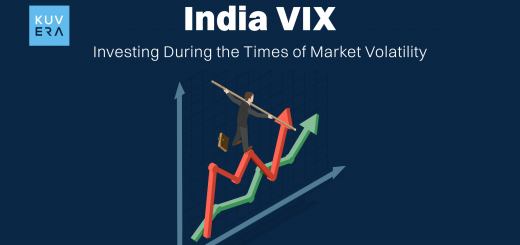Negative PE ratio? Sounds scary, isn’t it? We tend to associate a factor of caution on anything that turns out to be negative in the stock market. The negative PE ratio is no different. But, is it really concerning to have a negative PE ratio? Let’s understand the deeper meaning behind a negative PE ratio.
Meaning & Importance of P/E Ratio
The Price-to-Earnings (P/E) ratio is a financial metric used to assess the valuation of a company’s stock. It measures how much investors are willing to pay for each rupee of a company’s earnings. The P/E ratio is calculated as follows:
P/E Ratio=Share Price / Earnings Per Share (EPS)
Here’s what the P/E Ratio reveals:
Valuation: A higher P/E ratio might suggest that the stock is overvalued or that investors expect high growth rates in the future. Conversely, a lower P/E ratio might indicate that the stock is undervalued or that the company is experiencing difficulties.
Growth Expectations: Companies with high growth prospects generally have higher P/E ratios because investors expect future earnings to be substantially higher. In contrast, companies with lower growth prospects might have lower P/E ratios.
Industry Comparison: P/E ratios are often compared within the same industry. Different industries have varying average P/E ratios due to their growth rates and risk profiles.
Earnings Impact: The P/E ratio reflects market expectations about a company’s future earnings. A company with a negative EPS will have a negative P/E ratio, which can be less informative and require additional context.
Investor Sentiment: The P/E ratio can also provide insights into investor sentiment. A rising P/E ratio may indicate increasing investor confidence, while a declining P/E ratio might suggest waning confidence or perceived higher risk.
Growth vs. Value: Investors often use the P/E ratio to differentiate between growth and value stocks. Growth stocks typically have higher P/E ratios due to anticipated earnings growth, while value stocks may have lower P/E ratios, suggesting they are undervalued relative to their earnings.
What does a Negative P/E Ratio mean?
A negative P/E ratio occurs when a company’s earnings are negative. If a company’s EPS is negative (indicating a loss), this results in a negative P/E ratio. A negative P/E ratio can indeed be a red flag for investors but its significance depends on the context.
Start investing in Index Funds.
Why can it be a red flag?
1. Sign of Financial Distress
A persistent negative P/E ratio indicates that the company is consistently experiencing losses. This might signal deeper financial or operational problems such as declining revenues, poor cost management or ineffective business strategies.
2. Risk of Insolvency
Negative earnings over extended periods can raise concerns about a company’s ability to sustain operations. If losses continue without a clear path to profitability, the risk of insolvency or bankruptcy increases.
3. Market Sentiment
Companies with a negative P/E ratio might struggle to attract investment as investors typically seek out profitable companies. A negative P/E ratio might indicate a lack of confidence in the company’s future prospects or management.
When is a Negative P/E Ratio not a red flag?
1. High Growth Potential
For many startups and high-growth companies, especially in technology and biotech sectors, negative earnings can be a result of significant investment in R&D or market expansion. Investors might be willing to accept losses in the short term if they believe in the company’s potential for future growth and profitability.
2. Temporary Factors
A negative P/E ratio might be due to one-time events or extraordinary circumstances, such as asset write-downs, restructuring costs or legal settlements. If these are considered non-recurring, the company might be on a path to recovery.
3. Strategic Vision
If a company has a well-defined strategy for returning to profitability, a negative P/E ratio might be seen as a temporary phase. Effective management and a solid business model can mitigate concerns about current losses.
Examples of Negative P/E Ratio
First let’s take a look at an example with a positive P/E ratio
Company: Infosys Ltd.
Current Share Price: ₹1,500
EPS (Earnings Per Share): ₹75
P/E Ratio=₹1,500 / ₹75 = 20
Analysis: A P/E ratio of 20 means investors are willing to pay ₹20 for every ₹1 of earnings. This might be considered reasonable or high depending on industry averages and growth prospects. In the tech sector, a higher P/E ratio might be acceptable due to strong growth expectations.
Negative P/E Ratio
Company: Vodafone Idea Ltd.
Current Share Price: ₹10
EPS (Earnings Per Share): -₹5
P/E Ratio = ₹10 / -₹5= −2
Analysis: A negative P/E ratio indicates that Vodafone Idea is currently unprofitable. This could be due to various factors such as intense competition, high debt, or high operational costs. Investors need to assess whether the company’s financial struggles are temporary or part of a larger, ongoing issue.
Indian Stock Market Examples with Negative P/E Ratios
In the Indian stock markets, several companies have had periods of negative P/E ratios. Here are a few examples
1. Vodafone Idea Ltd. has faced significant financial challenges, including high debt and operational losses, leading to negative earnings. The negative P/E ratio reflects ongoing financial difficulties and the impact of competition in the telecom sector.
2. JSW Energy Ltd. has had positive P/E ratios in the past, it has also experienced periods of negative earnings due to factors such as fluctuating energy prices, regulatory changes and project delays. During these times, the P/E ratio was negative, indicating losses.
3. Tata Motors Ltd. has experienced negative earnings during periods of economic downturns or operational challenges, such as the global chip shortage affecting the auto industry. A negative P/E ratio during these times signalled financial stress but might also reflect temporary issues.
Key Considerations for Investors
1. Understanding the Causes
Investors should thoroughly analyse why a company is reporting negative earnings. An investor should examine the company’s financial statements and earnings reports to understand the reasons behind negative earnings. Are the losses a result of temporary issues such as market downturns or one-time expenses or are they indicative of fundamental problems within the company?
2. Assessing Longevity
It’s crucial to assess whether the company has a viable plan for turning around its financial situation. For example, are there clear strategies in place for cost control, revenue growth or strategic partnerships that could lead to future profitability? An investor should assess the company’s growth strategy, market position and competitive advantages and determine whether the company’s current losses are likely to be offset by future gains.
3. Risk Assessment
Investing in companies with a negative P/E ratio involves higher risk. It is essential to weigh the potential for high returns against the possibility of further losses or even bankruptcy. A detailed risk assessment and understanding of the company’s financial trajectory are necessary before making investment decisions.
4. Review Management and Strategy
An investor should evaluate the effectiveness of the company’s management team and their track record. A strong, experienced management team with a clear plan can improve the likelihood of overcoming current financial challenges.
Learn more about the stock market and stock market timings through here.
In Summary
The negative PE ratio of stocks may or may not be a concern for investors. It is therefore essential to learn and analyse other variables before making an investment decision.
Interested in how we think about the markets?
Read more: Zen And The Art Of Investing
Watch here: Investing In Passive Funds
Start investing through a platform that brings goal planning and investing to your fingertips. Visit kuvera.in to discover Direct Plans of Mutual Funds and Fixed Deposits and start investing today.
AREVUK Advisory Services Pvt Ltd | SEBI Registration No. INA200005166
DISCLAIMER: Mutual Fund investments are subject to market risks. Read all scheme related documents carefully. Registration granted by SEBI, membership of BASL (in case of IAs) and certification from NISM in no way guarantee performance of the intermediary or provide any assurance of returns to investors. Investments in securities market are subject to market risks. Read all the related documents carefully before investing. The securities quoted are for illustration only and are not recommendatory.












